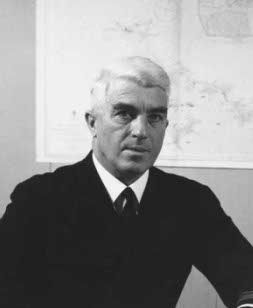![]() The Pacific War Online Encyclopedia
The Pacific War Online Encyclopedia
|
| Previous: Caliente | Table of Contents | Next: Cam Ranh Bay |

Cropped by
author
"Fighting Dan" Callaghan was born in San Francisco, the son of
a Roman Catholic banker, and
graduated from the Naval Academy in 1911 (ranking 39th in a class
of 193.) He served on battleship
California and participated in the Nicaragua intervention of
1912. He served in convoy
escorts in the First World War. Following the armistice, he was
assigned to the Navy Department, where he first met Franklin D. Roosevelt.
In 1938 Callaghan became naval aide to President Roosevelt, who took a personal interest in the careers of promising naval officers. Callaghan was the captain of the San Francisco at the time of the attack at Pearl Harbor. San Francisco was part of the fire support group for the initial Guadalcanal landings, and shortly thereafter Callaghan became chief of staff to Ghormley, the South Pacific theater commander.
Promoted to rear admiral, Callaghan was placed in command of the American force at the First Naval Battle of Guadalcanal (November 12-13, 1942) where he was killed by shellfire on the bridge of his flagship. The battle was a bloody, confused affair with high casualties on both sides, but it was a strategic American victory, since, in the process of getting itself shot to pieces, the American squadron inflicted sufficient damage on the Japanese squadron to prevent the Japanese from shelling Henderson Field.
"Uncle Dan" was relatively inexperienced in combat
operations, and he has been criticized for failing to broadcast a
battle plan or make the best use of his radar advantage. It has been
suggested that if the other admiral present, Norman Scott, had been
placed in tactical command,
the outcome would have been better, since Scott had recently
bested the Japanese at the battle of Cape
Esperance. However, Scott was a few weeks junior, and rigid
navy regulations meant Callaghan was automatically in command. In
any case, the ship dispositions chosen by Callaghan strongly
resembled those used by Scott at Cape Esperance.
Historians ought to be generous in judging Callaghan.
He was faced with a seemingly insoluble tactical problem, namely,
meeting an enemy force known from Allied reconnaissance to
contain battleships with his few cruisers
and destroyers, and
preventing it from bombarding Henderson Field. Hornfischer (2011)
interviewed an officer from San Francisco
who reported that both Callaghan and his flag captain believed
this to be a suicidal
mission:
"The wind carried their voices to me as I paced the deck and I was able to clearly observe the demeanor of each," Bennett said. "They were discussing the unannounced fact that there were battleships in the Tokyo Express.... Captain Young ... was in an understandably agitated state, sometimes waving his arms, as he remarked 'This is suicide.' Admiral Dan Callaghan replied, "Yes I know, but we have to do it." As Bennett saw it, Callaghan was "calm, unemotional, resolute and perhaps resigned to his fate."
However, the admiral courageously led his squadron in a
headlong charge into the enemy formation that brought his cruisers
close enough to Hiei
for their relatively light shells to inflict critical damage, and
which threw the Japanese force into sufficient confusion to prompt
the Japanese to withdraw. Callaghan accomplished his mission,
albeit at the cost of his own life.
We want the big ones. Get the big ones first!
—Callaghan's last signal
Callaghan was posthumously awarded the Medal of Honor. He was the
second highest ranking American naval officer killed in action in
the Pacific War. (The highest ranking was Rear Admiral Isaac Kidd,
killed on the bridge of the Arizona
in the Pearl Harbor
raid.) He had been popular with the crew of Portland while
serving as her executive officer, a significant deviation from
Navy tradition. It was rumored that his premature gray hair was
the product of a court-martial in 1915 for mismanagement of engine room equipment
(he was acquitted.) He was not a drinker,
though he did not preach temperance. Morison described him as
"austere, modest, deeply religious;
a hard-working and conscientious officer who possessed the high
personal regard of his fellows and the love of his men... There
was something a little detached about his man, since his thoughts
were often not of this world..."
| 1890-7-26
|
Born in San Francisco,
California |
|
| 1911 |
Graduated from Naval Academy |
|
| 1912-5-21 |
Ensign |
|
| 1915-5 |
Lieutenant junior
grade |
|
| 1918 |
Navy Department |
|
| 1920-10 |
Idaho |
|
| 1923-6 |
Board of Inspection and Survey, Pacific Coast Section | |
| 1925-5-16 |
Lieutenant |
Colorado |
| 1926-4 |
Mississippi | |
| 1928-7 |
Board of Inspection and Survey, Pacific Coast Section | |
| 1933 |
University of California |
|
| 1936 |
Commander |
Executive officer, Portland |
| 1938-7 |
Captain
|
Naval aide to President
Roosevelt |
| 1941-5 |
Commander, San Francisco |
|
| 1942-5 |
Rear Admiral | Chief of staff, South
Pacific
Area |
| 1942-10 |
Commander, Cruiser
Division 3 |
|
| 1942-11-13 |
Killed in action off Guadalcanal |
References
Murphy
(1954)
Pettibone (2006)
The Pacific War Online Encyclopedia © 2007-2009, 2013, 2017 by Kent G. Budge. Index